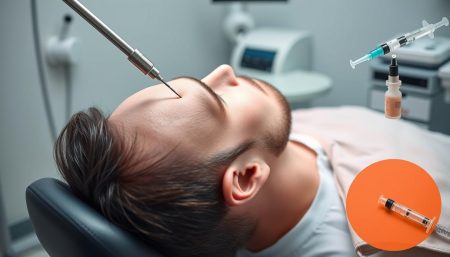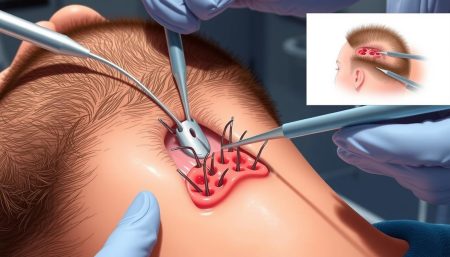Dealing with hair loss early on can be really tough. But, thanks to new medical tech, there’s hope. Hair restoration at 24 is now a real option for many facing early balding. Knowing about hair transplant age is key to getting back your youthful look and confidence.
Some might think getting a hair transplant at 24 is too soon. But, this section aims to clear up doubts and show the good results it can bring. It’s a light of hope for those fighting hair loss, turning fear into knowledge. Let’s explore the chances of early hair restoration and the positive changes it can bring.
Understanding Hair Loss at a Young Age
Exploring early hair loss helps us understand why some young adults lose hair early. Hair transplants at a young age are often misunderstood. They involve genetics, lifestyle, and health issues that can lead to hair loss.
This section looks at why young adults lose hair. Causes include genetics, stress, and not eating well. Knowing these reasons is key to finding treatments, like hair transplants.
- Genetic Predisposition: Family history often links to early hair loss. Genes can affect when and how much hair you lose.
- Hormonal Changes: Hormonal imbalances can cause hair loss early on. Issues like thyroid problems or hormone therapies play a big role.
- Lifestyle Factors: What you eat, stress levels, and sleep are important for your scalp. Poor management can speed up hair loss.
- Medical Conditions: Some autoimmune diseases and scalp conditions, like alopecia areata, can cause sudden hair loss in young adults.
Talking about hair loss and exploring options like hair transplants can help. It’s a way for many to get their hair and confidence back.
The Realities of Hair Transplant Procedures
Understanding hair transplant techniques is key for those considering it. Follicular Unit Extraction (FUE) and Follicular Unit Transplantation (FUT) are two main methods. Each has its own benefits and drawbacks, making it important to choose wisely.
Comparing FUE and FUT Techniques
FUE vs FUT—this debate is central to hair transplant options today. The choice between these methods affects the outcome, recovery time, scarring, and the look of your hairline.
| Feature | FUE | FUT |
|---|---|---|
| Scarring | Minimal, punctate scars | Linear scar at donor site |
| Technique | Individual follicle extraction | Strip of tissue removed |
| Recovery Time | Shorter, a few days | Longer, several weeks |
| Suitability | Shorter hair styles | Longer hair, higher density |
| Cost | Higher, labor-intensive | Generally less expensive |
Long-term Efficacy and Results
The success of a hair transplant depends on the method and how well the body responds. Both FUE and FUT can lead to long-term growth. But, the quality of results can vary based on the procedure’s quality and post-care.
FUE is often chosen for its minimal scarring and quick recovery. FUT is preferred for those wanting fuller hair. Always consult a skilled specialist for personalized advice.
Can I Be 24 and Have a Hair Transplant?
Thinking about hair transplant eligibility at 24 involves looking at several important factors. Dermatologists and hair experts often talk about this with young adults. They want to help those who are losing hair early.
This part looks at what young adults need to know about hair transplants at 24. It’s important to understand the medical, mental, and practical sides of it. This helps them make a good choice.
- Age and Hair Loss Progression: How fast hair loss happens is key. Doctors check if it will keep going and how fast.
- Donor Hair Quality: Having enough good hair to use is very important. This is a big part of deciding if you can get a transplant.
- Health Considerations: Your overall health and any skin or scalp problems can affect the transplant. They might make it harder or riskier.
| Age | Typical Eligibility Concerns | Suggested Action |
|---|---|---|
| 24 and under | Rapid progression of hair loss, unstable donor areas | Further evaluation needed; possibly delayed action |
| 25-30 | Stabilization of hair loss patterns, healthy donor area confirmed | Eligible for consideration with favorable prognosis |
Deciding on hair transplant eligibility at 24 is complex. It needs a detailed check by experts. They look at the health and emotional sides of getting a transplant young. A detailed talk can help young adults make a smart choice for their situation.
Assessing Candidacy for a Hair Transplant at 24
Thinking about a hair transplant at 24? It’s key to check if you’re a good candidate. Doctors look at how much hair you’ve lost and if the area where hair grows is healthy. These things help decide if the transplant will work well.
Evaluating the Degree of Hair Loss
Checking how much hair you’ve lost is a big part of being a candidate. Even at 24, it’s not just about how much hair you have now. They also look at how fast you’re losing it and where. A full scalp check helps figure out how much hair you’ve lost and where.
The Importance of a Stable Donor Area
The area where hair grows is very important for hair transplants. It needs to be healthy and have enough hair to cover the bald spots well. Doctors check how dense the hair is, how thick the hair shafts are, and how flexible the scalp is.
Doctors also look at your genes and family history of baldness. This helps them guess how much hair you might lose in the future. This complete check helps figure out if you’re a good candidate now and in the future.
| Assessment Criteria | Importance in Transplant Success |
|---|---|
| Degree of hair loss | Critical for defining the scope of the transplant area |
| Donor area stability | Essential for the viability and longevity of the transplant |
| Scalp elasticity | Important for ease of follicle extraction and placement |
| Family history of baldness | Useful for predicting future hair loss and planning |
Psychological Impact of Early Hair Loss
Experiencing hair loss at a young age can be very distressing. It affects not just how you look but also your emotional well-being. The psychological effects of hair loss are big and can cause social anxiety, depression, and lower self-esteem.
Many people struggle in silence, feeling isolated. But it’s important to understand the bigger picture for overall health. For more on alopecia and its emotional effects, check out this article.
Looking into how hair loss affects daily life and self-image shows it’s more than looks. The path to emotional well-being is complex.
| Impact | Psychological Effect | Common Reactions |
|---|---|---|
| Self-Perception | Reduced self-esteem | Withdrawal from social situations |
| Interpersonal Interactions | Increased self-consciousness | Hesitance in forming new relationships |
| Professional Life | Perceived diminished competence | Decreased participation in professional activities |
To lessen these effects, a supportive environment and professional help are key. Counseling and therapy can help restore hair and a person’s sense of self and stability.
The Timeline of Hair Restoration
Starting a hair restoration journey means knowing the timeline well. It covers from the first talks to the recovery and growth stages. It’s a detailed plan to help people through the journey of getting their hair back.
Pre-procedure Consultations
Before a hair transplant, there are important talks. Doctors check how much hair is lost and talk about how to fix it. They also set clear goals for what to expect.
These talks make sure people know what’s coming. They learn about the steps and what it takes for hair to grow back.
Post-procedure Recovery and Growth
The recovery time after a transplant is key. The first weeks might have some swelling and pain, but it gets better. Taking good care of the hair is important during this time.
After two to three months, new hair starts to show. This is the start of seeing real changes.
- Week 1-2: Managing post-surgery care and watching for signs
- Month 1-3: Expecting some hair loss, which is normal
- Month 4-6: Seeing new hair growth
- Month 6-12: Hair gets thicker and softer
This is a general timeline, but everyone’s experience is different. Talking a lot during the first talks helps set a plan that fits you. This way, everyone knows what to expect.
Hair Transplant Techniques Suitable for Young Adults
Looking into the best hair transplant methods shows some are perfect for young adults. These methods not only look great but also fit well with a young person’s lifestyle and hair health.
Choosing the right hair transplant for young adults depends on their hair loss and donor site health. Let’s explore why some methods are top choices for young hair restoration.
- Follicular Unit Extraction (FUE): This method is gentle, taking out hair follicles one by one. It’s less painful and heals quickly.
- Follicular Unit Transplantation (FUT): It removes a skin strip, then cuts it into grafts. It might leave a scar but can give strong results and more grafts at once.
Choosing between FUE and FUT should be after talking to a skilled surgeon. They will help pick the best method for today’s hair transplants.
| Technique | Benefits | Considerations |
|---|---|---|
| Follicular Unit Extraction (FUE) | Less invasive, no linear scarring, quicker recovery time. | Longer session duration, higher cost |
| Follicular Unit Transplantation (FUT) | More grafts in a single session, potentially thicker results. | Linear scar, longer recovery period. |
Knowing about hair transplant for young adults options helps make smart choices. These choices are based on health, looks, and lifestyle. This knowledge is key to getting a young, full hairline that can fight off future hair loss.
Risk Factors to Consider Before a Hair Transplant
Before getting a hair transplant, it’s important to know the hair transplant risk factors. Your age can affect how well the transplant works and lasts. We’ll look at the possible complications of hair transplant and why it’s key to think about future hair loss, even if you’re young.
Potential Complications and Side Effects
Getting a hair transplant can lead to different problems and side effects. These can be small issues or serious health problems that might affect your health long-term. Here are some major risks:
- Infection and scarring at the transplant sites.
- Shock loss, or temporary hair shedding post-procedure.
- Persistent pain or numbness in the treated areas.
- Possible allergic reactions to anesthesia or other medications used during the procedure.
Everyone reacts differently to the surgery, so the complications of hair transplant can vary a lot.
Assessing the Risk of Future Hair Loss
One big hair transplant risk factor is the chance of more hair loss in the future. It’s important for patients, and young ones in particular, to be ready for this. Talking about how long the results will last and how to keep them looking good is key.
| Risk Factor | Impact on Hair Transplant Outcome |
|---|---|
| Age at the time of the procedure | Younger patients may experience ongoing hair loss, affecting long-term results. |
| Genetic predisposition to hair loss | Genetics play a significant role; future hair loss could negate initial positive outcomes. |
| Quality of donor hair | Poor donor hair quality can lead to unsuccessful transplants or unnatural-looking results. |
Knowing about these risks is key to making a good choice. Anyone thinking about a hair transplant should talk about these risks with a specialist. For more information on timing and options, check out this resource.
Setting Realistic Expectations for Young Patients
When thinking about a hair transplant, young patients need to know what to expect. It’s important to understand that hair restoration is a journey, not a quick fix. This mindset can greatly affect how happy and emotionally well a patient feels.
Hair transplants can help restore hair, but how long it lasts can vary. Young people might need more treatments in the future. Knowing this helps them manage hair loss better, using both surgery and other treatments.
- Understanding the nature of your hair loss and its possible progression.
- Talking in detail with your surgeon about what results you can expect.
- Thinking about the need for more procedures as you get older.
Looking at before and after photos of people your age and with similar hair loss can help. It gives you a clear idea of what’s possible. It’s also key to talk to a trusted specialist who knows about young patient hair restoration outcomes. They can help set realistic goals and plan for the long term.
Talking openly with your healthcare team is important. It makes sure your hopes match what’s possible. This leads to happiness and a positive view of hair restoration’s ongoing journey.
Hair Transplant Success Stories at Young Age
Looking at those who got hair transplants young can give hope. It shows these procedures work for the young too. Their stories are not just medical wins but personal victories against early hair loss.
Inspirational Cases and Testimonials
Many have found success in hair transplants early on. Thanks to early action and skilled care, their self-esteem and life quality have improved. Their stories highlight the success of new medical methods for young patients with hair loss.
Visual Evidence of Young Age Transplants
Visual proof is key when talking about hair transplants for the young. Below, a table shows before and after photos. These images show not just hair growth but also the confidence and happiness from successful surgeries.
| Age at Transplant | Before Image Description | After Image Description | Time Post-Transplant |
|---|---|---|---|
| 24 | Significant receding hairline | Dense, natural hairline | 1 Year |
| 26 | Thinning on crown | Full coverage on crown | 2 Years |
| 23 | Overall thinning | Thick, healthy hair all over | 1.5 Years |
The Financial Aspect of Hair Transplantation at 24
Choosing to get a hair transplant at 24 is more than just a personal choice. It also comes with financial costs. The cost of hair transplant changes based on the method, the surgeon’s skill, and where the clinic is. Knowing these costs is key for anyone thinking about this big hair restoration investment.
For many, getting a hair transplant at 24 is not just about fixing hair loss. It’s also about boosting self-esteem and improving social life. This part aims to explain the typical costs of a hair transplant. It looks at the upfront cost and the long-term benefits.
- The average cost of hair transplant in the U.S. is between $4,000 and $15,000. This depends on how many grafts you need and the method used.
- The price also changes based on the surgeon’s reputation and where the clinic is.
- Most health insurance doesn’t cover hair transplants. But, some might cover post-op care or medical issues that arise.
Getting a hair transplant is just the start. You’ll also need to think about ongoing costs for maintenance and future treatments. Planning your budget carefully is essential for this investment in your looks and health.
| Procedure | Cost Range | Notes |
|---|---|---|
| FUE (Follicular Unit Extraction) | $6,000 – $15,000 | Less invasive, leaves no linear scars |
| FUT (Follicular Unit Transplantation) | $5,000 – $12,000 | More extensive, often results in a linear scar |
Before deciding on a hair transplant, it’s smart to talk to several clinics. This way, you get a full picture of costs and what to expect. Seeing the cost as an investment can change how you view its benefits. It can open up new life experiences and opportunities.
Future Hair Loss Considerations
It’s important for young people to understand how hair loss can progress. By looking at future hair loss predictions, they can plan better for their hair health. This part talks about how to predict hair loss and treatments to keep hair healthy longer.
Predicting Progressive Hair Loss Patterns
Doctors use genetic tests and scalp analysis to predict hair loss. These predictions help plan hair restoration strategies. Important tools include:
- Dermatoscopic examinations to check hair follicle density and quality.
- Genetic tests to see if you’re likely to lose hair due to genetics.
- Computer tracking of hair loss over time.
These tools help understand hair loss patterns. They also help tailor treatments that work well for each person.
Proactive Treatments and Maintenance
After understanding hair loss patterns, you can start treatments to slow it down. These treatments include:
- Topical applications like minoxidil to grow hair and slow loss.
- Oral medications like finasteride to block hormones that thin hair.
- Advanced therapies like PRP and Laser Therapy to boost scalp health.
Starting treatments early is key. It keeps hair transplant results looking good and improves scalp health.

Being proactive with hair loss management is very important. It helps keep hair transplant results looking great. It also boosts confidence and mental health.
Medical Alternatives to Hair Transplant for Young Adults
Young people looking into hair loss alternatives might find non-surgical medical hair restoration options appealing. The medical field has made great strides, leading to various treatments. These aim to tackle hair loss at its source, with good results.
Medical treatments like Minoxidil and Finasteride can help hair grow or stop it from falling out. For those concerned about side effects, low-level laser therapy is a chemical-free option. It works by boosting scalp activity and making hair follicles thicker and fuller.
| Treatment Type | Description | Pros | Cons |
|---|---|---|---|
| Minoxidil (Topical) | Over-the-counter solution applied directly to the scalp. | Non-invasive, easy to use | Requires consistent application |
| Finasteride (Oral) | Prescription pill that inhibits hair loss hormones. | Potent, prescribed for more severe cases | Potential hormonal side effects |
| Laser Therapy | Utilizes medical-grade lasers to stimulate hair follicles. | No chemical side effects, non-invasive | Multiple sessions required |
PRP (Platelet-Rich Plasma) treatments are also a key part of medical hair restoration options. By injecting one’s plasma into the scalp, it boosts natural hair growth. This can be a great addition to other treatments.
- Vitamin and mineral supplements can fortify hair strength.
- Scalp massages to increase blood circulation.
- Dietary modifications that encourage biotin and protein intake.
Choosing these hair loss alternatives is a good option for those wanting to slow down baldness. They offer a non-surgical way to address hair loss. Young adults can explore these options or use them alongside hair transplant procedures in the future.
Q&A with Hair Restoration Experts
Getting expert advice on hair transplants and insights from a specialist Q&A is key for those thinking about it, like young adults. We tackle some common questions from those considering it.
- What is the ideal age for a hair transplant?
There’s no single answer, but the best candidates know their hair loss pattern well. Talking to a specialist can help clear things up. - How does one choose the right technique?
Choosing between FUE and FUT depends on hair loss extent, hair type, and health. A detailed talk with a hair restoration expert can guide the right choice. - What can be expected in terms of recovery?
Recovery varies by person and method. Most can go back to work in a few days. But, full healing takes weeks. You’ll get detailed care instructions for the best results. - Are there any risks associated with young adults getting a hair transplant?
Risks include infection, hair that looks unnatural, and more hair loss. But, these can be lessened with good care and a skilled team.
It’s vital to have specialist Q&A sessions for expert advice on hair transplants. This ensures you’re well-informed and ready for what’s next.
Hair Transplant Technology: Advances and Innovations
Looking ahead, big steps in hair transplant advances are changing how we see hair loss. New methods and tech breakthroughs are making hair transplants better for young people. The latest hair restoration technology makes transplants more precise and healing faster, leading to better results.
Automation and robotics are leading the way in hair transplant tech. Robots help make the process more accurate and quick. They also reduce scarring and mistakes. Plus, new imaging tech lets surgeons plan and do transplants with more detail than ever before.
Stem cell therapy and gene editing are on the horizon. They might even stop baldness before it starts. While these are being worked on, they show the field’s drive for new solutions. As hair transplant advances keep growing, we’re here to help those dealing with hair loss. The latest hair restoration technology brings hope for a future where hair loss isn’t a big deal.
FAQ
Q: Can a 24-year-old successfully undergo a hair transplant?
A: Yes, a 24-year-old can get a hair transplant if they have enough donor hair and significant hair loss.
Q: What causes hair loss at a young age?
A: Hair loss in young people can come from genetics, hormonal changes, medical issues, stress, and lifestyle choices.
Q: Are FUE and FUT hair transplant techniques suitable for young adults?
A: Both FUE and FUT can work for young adults. The best choice depends on the hair loss and the surgeon’s advice.
Q: What factors determine hair transplant eligibility at 24?
A: To be eligible at 24, you need to have enough hair loss, a stable donor area, and understand future hair loss.
Q: How does early hair loss affect psychological well-being?
A: Early hair loss can really affect how you feel about yourself. It can lead to low self-confidence and self-esteem issues.
Q: What is the typical timeline for hair restoration?
A: The timeline includes talking to a doctor, the transplant, recovery, and waiting for hair to grow. It takes months to see the full results.
Q: What are the risk factors to consider before undergoing a hair transplant at a young age?
A: Young people should think about surgery risks and future hair loss. These can affect the transplant’s long-term success.
Q: How can young patients set realistic expectations for hair transplant results?
A: Young patients should talk to their surgeons about what the surgery can and can’t do. They should understand they might need more procedures as they age.
Q: Can you share any success stories of hair transplants at a young age?
A: Yes, there are many inspiring stories of young people who got successful hair transplants. They often share photos of their results.
Q: How much does a hair transplant cost for someone who is 24?
A: The cost for a 24-year-old varies based on the procedure, hair loss, and clinic location. It’s seen as an investment in their quality of life.
Q: How do experts predict and manage future hair loss after a transplant?
A: Experts look at patient history, hair loss patterns, and sometimes genetic tests to predict future loss. They might recommend treatments like medications or laser therapy.
Q: Are there medical alternatives to hair transplants suitable for young adults?
A: Yes, young adults have non-surgical options like FDA-approved medications, low-level laser therapy, and platelet-rich plasma (PRP) treatments.
Q: What advice do experts give to young adults considering hair transplants?
A: Experts say young adults should research the procedure, choose a good surgeon, and have realistic expectations about results and future hair loss management.
Q: What advances in hair transplant technology might benefit young adults?
A: New technologies like robotic-assisted hair transplantation, better graft survival, and regenerative therapies are helping young adults with hair restoration.


















